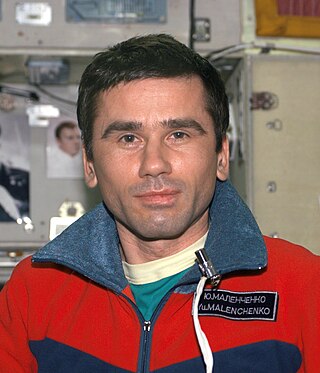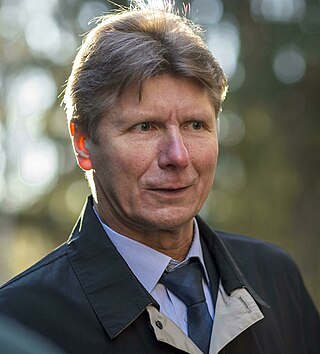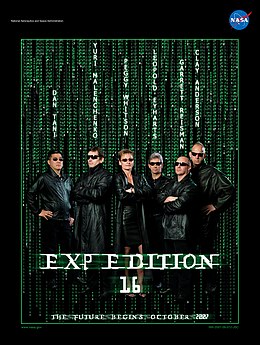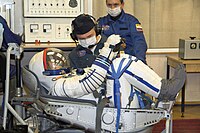
Yuri Ivanovich Malenchenko is a retired Russian cosmonaut. Malenchenko became the first person to marry in space, on 10 August 2003, when he married Ekaterina Dmitrieva, who was in Texas, while he was 240 miles (390 km) over New Zealand, on the International Space Station. As of December 2023, Malenchenko ranks third for career time in space due to his time on both Mir and the International Space Station (ISS). He is a former commander of the International Space Station.

Michael López-Alegría is an astronaut, test pilot and commercial astronaut with dual nationality, American and Spanish; a veteran of three Space Shuttle missions and one International Space Station mission. He is known for having performed ten spacewalks so far in his career, presently holding the second longest all-time EVA duration record and having the fifth-longest spaceflight of any American at the length of 215 days; this time was spent on board the ISS from September 18, 2006, to April 21, 2007. López-Alegría commanded Axiom-1, the first ever all-private team of commercial astronaut mission to the International Space Station, which launched on April 8, 2022, and spent just over 17 days in Earth's orbit.

Yury Valentinovich Lonchakov is a Russian former cosmonaut and a veteran of three space missions. He has spent 200 days in space and has conducted two spacewalks. From 2014 to 2017, Lonchakov served as head of the Yuri Gagarin Cosmonaut Training Center.

Peggy Annette Whitson is an American biochemistry researcher, and astronaut working for Axiom Space. She retired from NASA in 2018, after serving as Chief Astronaut. Over all her missions, Whitson has a total of 675 days in space, more than any other American or woman.

STS-106 was a 2000 Space Shuttle mission to the International Space Station (ISS) flown by Space Shuttle Atlantis.

Scott Joseph Kelly is an American engineer, retired astronaut, and naval aviator. A veteran of four space flights, Kelly commanded the International Space Station (ISS) on Expeditions 26, 45, and 46.

Gennady Ivanovich Padalka is a Russian Air Force officer and Roscosmos cosmonaut. Padalka held the world record for the most time spent in space at 878 days until Oleg Kononenko broke this record on February 4, 2024 at 07:30:08 UTC and is currently at 2nd position. He worked on both Mir and the International Space Station.

Daniel M. Tani is an American engineer and retired NASA astronaut. He was born in Ridley Park, Pennsylvania, but considers Lombard, Illinois, to be his hometown.

Mikhail Vladislavovich Tyurin is a former Russian cosmonaut who flew several missions to the International Space Station and completed four spacewalks during his career. He was awarded the title Hero of the Russian Federation for his work as a cosmonaut.

Fyodor Nikolayevich Yurchikhin is a Russian cosmonaut of Greek descent, engineer and RSC Energia test-pilot who has flown on five spaceflights. His first spaceflight was a 10-day Space Shuttle mission STS-112. His second was a long-duration stay aboard the International Space Station (ISS) as a flight engineer for Expedition 15; for this mission he was launched in the Soyuz TMA-10 spacecraft. He has undertaken two further long-duration stays aboard the ISS, as a crew member of Expedition 24 / 25. For this mission he was launched with the spacecraft Soyuz TMA-19, and he landed in November 2010, also with the Soyuz TMA-19 spacecraft. He served as Soyuz commander for his fourth mission aboard Soyuz TMA-09M, as flight engineer for Expedition 36 and ISS commander for Expedition 37. In April 2017, Yurchikhin launched on Soyuz MS-04 for the fifth spaceflight of his career, a six-month mission to the ISS as part of Expedition 51 and 52, for which he was the commander.

Pavel Vladimirovich Vinogradov is a former cosmonaut and commander of the International Space Station. He has flown into space three times, aboard Mir and the International Space Station, and was one of the top 10 astronauts in terms of total time in space after his third spaceflight. Vinogradov has also conducted seven spacewalks in his cosmonaut career, and holds the record for the oldest person to perform a spacewalk.

Robert Shane Kimbrough is a retired United States Army officer and NASA astronaut. He was part of the first group of candidates selected for NASA astronaut training following the Space Shuttle Columbia disaster. Kimbrough is a veteran of three spaceflights, the first being a Space Shuttle flight, and the second being a six-month mission to the ISS on board a Russian Soyuz craft. He was the commander of the International Space Station for Expedition 50, and returned to Earth in April 2017. He is married to the former Robbie Lynn Nickels.

Sunita Lyn Williams, nicknamed Suni in the United States and Sončka in Slovenia, is an American astronaut, United States Navy officer, and former record holder for most spacewalks by a woman (seven) and most spacewalk time for a woman. Williams was assigned to the International Space Station as a member of Expedition 14 and Expedition 15. In 2012, she served as a flight engineer on Expedition 32 and then commander of Expedition 33.

STS-120 was a Space Shuttle mission to the International Space Station (ISS) that launched on October 23, 2007, from the Kennedy Space Center, Florida. The mission is also referred to as ISS-10A by the ISS program. STS-120 delivered the Harmony module and reconfigured a portion of the station in preparation for future assembly missions. STS-120 was flown by Space ShuttleDiscovery, and was the twenty-third Space Shuttle mission to the ISS.

Expedition 12 (2005) was the 12th expedition to the International Space Station, launched from Kazakhstan using the Russian Soyuz TMA-7 spacecraft. The crew landed back in Kazakhstan on 8 April 2006 with the addition of the first Brazilian astronaut, Marcos Pontes.

STS-122 was a NASA Space Shuttle mission to the International Space Station (ISS), flown by the Space ShuttleAtlantis. STS-122 marked the 24th shuttle mission to the ISS, and the 121st Space Shuttle flight overall.

Expedition 14 was the 14th expedition to the International Space Station (ISS). Commander Michael López-Alegría, and flight engineer Mikhail Tyurin launched from Baikonur Cosmodrome on 18 September 2006, 04:09 UTC, aboard Soyuz TMA-9. They joined Thomas Reiter, who had arrived at the ISS on 6 July 2006 aboard Space Shuttle Discovery during mission STS-121. In December 2006, Discovery mission STS-116 brought Sunita Williams to replace Reiter as the third member of Expedition 14. On 21 April 2007, López-Alegría and Tyurin returned to Earth aboard TMA-9. Landing occurred at 12:31:30 UTC.

Expedition 15 was the 15th expedition to the International Space Station (ISS). Four crew members participated in the expedition, although for most of the expedition's duration only three were on the station at any one time. During Expedition 15, the ISS Integrated Truss Structure was expanded twice: STS-117 brought the S3/S4 truss, and STS-118 brought the S5 truss.

Akihiko Hoshide is a Japanese engineer, JAXA astronaut, and former commander of the International Space Station. On August 30, 2012, Hoshide became the third Japanese astronaut to walk in space.

Sergey Aleksandrovich Volkov is a retired Russian cosmonaut and engineer. He was a member of three missions to the International Space Station, spending more than a year in total in space. During his missions he did four spacewalks lasting more than 23 hours in total. Volkov retired from the Cosmonaut group in February 2017.



























